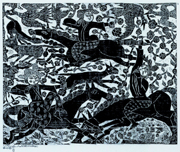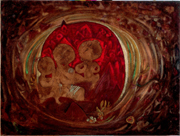Munakata Shiko and Choi Young-Lim
From Nov.10th 2007 through Dec.24th 2007, our museum co-hosts the temporally exhibition “Munakata Shiko and Choi Young-Lim” with The Deoksugung National Contemporary Museum of Art in South Korea.
This exhibition turns the spotlight on two artists.

Munakata Shiko, In Praise of Flower Hunting,1954

Choi Young-Lim, Mercy of Buddha,1967
Aomori Museum of Art
| Address | 185 Chikano, Yasuta, Aomori, Aomori, 038-0021, Japan |
|
| TEL | 017-783-3000 | |
| bijutsukan@pref.aomori.lg.jp | ||
| Access | (JR) 20 minutes by car from JR Aomori Station (Aomori Municipal bus.) 20 min. by bus bound for “MENKYO-CENTER via Art Museum” from JR Aomori Station.The Bus Stop “Kenritsu-bijutsukan-mae” (Airport) 20 minutes by car from the Aomori Airport. (Highway) 5 minutes by car from the Tohoku Expressway Aomori Interchange
|
Details
Period
2007/11/10 (SAT) – 2007/12/24 (MON)
Hours
9:30 – 17:00
Admission
Special exhibition + Aleko Hall (*)
Adults / 800 (700) yen
High School & College & University / 560 (460) yen
Schoolchildren & Junior High School / 320 (220) yen
Special exhibition + Collection Gallery
Adults / 1,200 (1,100) yen
High School & College & University / 800 (700) yen
Schoolchildren & Junior High School / 400 (300) yen
Exhibition Structure
One is the world wide famous Japanese artist Munakata Shiko (1903-1975), the other is the top Korean artist Choi Young-Lim (1916-1985).
Especially in Japan, Choi is well known that his later artworks were influenced by Munakata.
Choi was born in Pyongyang which had been occupied by Japan, and he learned woodprints from Japanese artist and archeologist Ono Tadaakira who stayed in the Pyongyang Museum in the mid 1930’s.
Inspired by Ono, Choi decided to go to Japan in 1938 to brush up his art skills.
Then he met one of Ono’s best friends, Munakata.
When the Korean War broke out, he escaped to the present South Korea leaving his family, but as one of the best Korean artists, he continued to create artworks through the rest of his life.
His 1950’s artworks characterized a dark color such as black due to his sorrow separation with his family or the civil war among his compatriots.
Searching something peculiary Korean, his art image color gradually changed to the brighter color, ocher or light brown.
From late 1960’s to the later of his life, he often adopted the legends of Korea and Buddhism or a naked woman in the nature as a motif in his oil paintings.
Those paintings, which were painted in a method for mixing clay with sand like a mural, are called an art of “the Paradise Days”.
And he started to change his woodprints in the basic tone of black and white which was apparently influenced by Munakata.
Our exhibition proudly selected his 78 masterpieces through his life as an artist.
We are also proud of exhibiting those for the first time in Japan.
So far, the relationship between Munakata and Choi was not well known in detail.
However, we found Munakata’s fourteen letters (from late 1965 to New Year of 1975) in Choi’s mementos in the process of this exhibition.
Munakata conveyed his regret for what he might not see Choi again in the last letter while he was ill in bed.
Choi replied then “Our friendship over the decades is so firm that you don’t have to rush to meet me now. I’ll wait your recovery.”
We could sense their friendship through the letter.
Please feel their profound relationship reading an authentic letters in this exhibition.
In the large exhibition room with high ceiling and the white and dark brown wall, we installed Munakata’s masterpieces such as twelve woodprint series called “Two Bodhisattva and Ten Great Disciples of Sakyamuni”, an 8 meter-wide paint called “An Eagle Eyrie”, a 7 meter-wide and 2.5 meter-high woodprint called “A Flower Arrow”, a 10 meter-wide woodprint called “In Praise of Tohoku District”.
We couldn’t realize to showcase all those magnificent masterpieces without these spacious exhibition rooms.
This is a first exhibition in both countries to focus on two famous contemporary artists spotlighting on their friendships.
This exhibition goes on tour to The Deoksugung National Contemporary Museum of Art in South Korea from Jan.22 2008 through Mar.30 2008.

